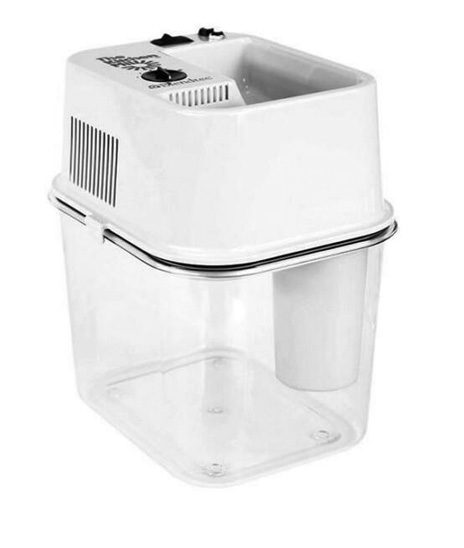
Grain Mills, Bread Mixers, and Kitchen Tools
Five Things You Can Do Now
- Identify and purchase various hand-held nonelectric kitchen tools that would work in place of electric tools.
- If you do not own one, compare several grain mills and decide which one would best suit your needs.
- If you do not own one, compare several bread mixers and decide which one would work for you.
- Explore making cheese or yogurt and determine what supplies and tools you will need to make them.
- Make a master list of tools and supplies you would like to acquire. Use the tools and supplies listed in tables 19.7, 19.8, and 19.9 as a guide.
To properly prepare food in a prolonged crisis, it’s likely you’ll need specialized equipment and supplies. This is especially true if your preparedness storage food is different from your normal daily food. Some storage foods need processing with specialized tools you’ll need to purchase. The right equipment and supplies can make a crisis less stressful.
Since electric power can be nonexistent or only available on an intermittent basis during a crisis, you may need an alternative to the electric appliances found in most kitchens. For those appliances you consider indispensable, it’s wise to have a nonelectric choice.
You also may want a backup power source. More information about energy sources in a crisis can be found in chapter 37.
Grain Mills
A grain mill is the single-most-important tool you need to use whole grains.
A grain mill is indispensable when it comes to using stored whole grains. Mills may be electric or manual and may grind grain using stones or metal burr plates. Consider and examine assorted mills. Ask for a demonstration and check reviews. Make sure you get good answers about the mill’s capabilities and durability.
Personally Speaking
One of my most important suggestions is that you use your grains consistently, especially wheat! There are lots of compelling reasons for using grains. To begin with, lightly-processed whole grains are healthy, as vitamins are at their peak in freshly ground wheat. Research is showing that a whole-food, plant-based diet lowers cholesterol, blood pressure, and blood sugar and even reverses or prevents heart disease.
Also, whole-wheat bread made at home, in my opinion, is better tasting than store-bought. Plus, it is a great bargain! Learning to make bread is an important survival skill. It gives you the confidence that you can be self-reliant. To get the most out of whole grains, it really helps if you have the right equipment, and that begins with a grain mill.
You can choose from a variety of high-quality electric and manual mills as well as some dual-function mills. And you’ll need to decide what you’ll use a grain mill for. Do you want a mill to grind fine flour for baking, or to crack wheat for cereals, or both? Are you going to need it for hard, dry grains like wheat, oily seeds like soybeans, or for making peanut butter? Will you use it regularly, and can it be stored conveniently? Do you want it to be a permanent fixture on the kitchen counter, or will you put it away when not using it? Use the Quick Check to help you decide what qualities you want in a grain mill.
Grinding Burrs or Stones
The most popular burr mills have two grinding burr plates that may be made of hardened cast steel, steel alloy, or corundum — a synthetic aluminum-oxide ceramic. These are all extremely hard and considered to be an improvement over older-model mills with plates made from actual stone. They are used in both electric and manual mills.
In most mills, one burr plate is fixed and the other rotates against it. Some mill designs have cone-shaped grinding burrs. Either way, the grain is pressed and crushed between the burrs to make flour. How closely the plates or cones grind together determines the coarseness of the flour. Depending on what they are made of, some grinding burrs will grind soybeans, oily seeds, and nuts without clogging or absorbing the oil and can be removed and cleaned.
Some well-crafted mills grind with real stones but require more physical effort to get fine flour. Stones also may produce powder when cracking grain or splitting peas. Generally, high-quality stones make finer flour, wear longer, create slightly less heat at finer settings, and are quieter than impact steel burrs. The grind also improves with age as the stones grind themselves to a perfect fit. The tradeoff is the effort needed to grind the grain if using a manual mill.
Impact Grinding Plates
Stainless-steel grinding plates are found in electric mills with powerful motors of one thousand watts or more and are made with two flat, stainless-steel heads with concentric rows of “teeth” that spin within each other at high speeds, bursting the grain kernels at a fast rate. This is called impact grinding, or “micronizing.” While they grind grains fast, the process is quite noisy, though some mill brands try to deaden the noise. If you frequently make multiple loaves of bread, this kind of mill is an excellent choice, but it will only grind hard grains and not make cracked wheat. The best way to approximate cracked wheat is to grind the wheat on the coarsest setting and then sift to remove the finer flour.
Electric Mills
For effortless convenience, you can’t beat an electric mill. For bread making, look for a heavy-duty mill that will produce fine flour. Some electric mills may have stainless-steel grinding plates. They can be loud and may spit out a fine dust. The housings are usually hard plastic. Their faster grind creates hotter temperatures, but the nutritional value is affected only slightly because of the short grinding time. You can grind enough flour for a bowl of waffle batter or a batch of bread in just minutes.
There are also several electric mills with a synthetic ceramic stone milling action. These mills make exceptionally fine-textured flour and are slower and quieter than the electric mills with stainless-steel grinding plates. And they are attractive enough to sit on a kitchen counter where you can grind flour as needed.
Electric Impact Mills
Blendtec Kitchen Mill
The Blendtec Kitchen Mill (pictured) is an excellent impact mill. It is compact, can be stored in a kitchen cupboard, and is simple to set up, but be sure you attach the cyclone cup and insert the porous “F filter” according to the directions so flour won’t blow all over your kitchen. Also take care with the side latches, which are somewhat vulnerable to breaking. This mill can be cleaned with a stiff paintbrush or damp cloth.
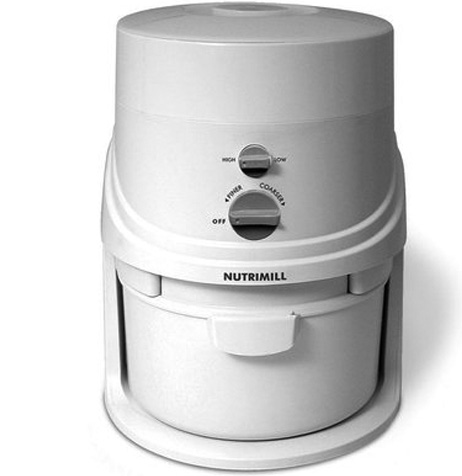
It will grind grains, including corn, buckwheat, pinto beans, and soybeans, as well as nonoily legumes, but not moist or oily grains, nuts, seeds, or coffee. It is noisy and takes about two minutes to grind a pound of wheat, but the hopper can be continuously fed and the mill pan will hold twenty-four cups of flour.
NutriMill Classic Grain Mill
The NutriMill made by L’Equip (pictured) is another excellent grain mill that uses an impact chamber with steel burrs to grind fine flour for bread. It also has a unique feature that allows you to slow the RPMs and grind a coarse texture cream of wheat or cornmeal for cereal. It will also grind grains and nonoily legumes, though it’s not suitable for moist or oily grains, nuts, seeds, or coffee. And there’s a bagger attachment available where you can easily freeze your flour or share it with friends.
The WonderMill Electric Grain Mill
The WonderMill (pictured) is a first-rate impact grain mill that produces both coarse and pastry flours. It is simple to operate, but one downside is that you must remember to turn the mill on before starting and not turn it off in the middle of grinding. It will grind most grains and nonoily legumes but not oily seeds, nuts, or coffee. It has two main components—the mill and the collection canister, which will hold twelve to thirteen cups of flour.
Electric Stone-Grinding Mills
KoMo Classic Grain Mill
The KoMo Classic Grain Mill is an exceptional electric stone grain mill that produces superbly fine flour at a fast rate as well as cracked wheat for cereal. It is attractive and grinds directly into your own bowl, with virtually no dust. It is the kind of appliance you would like on your countertop to use whenever you need as little as a tablespoon of flour. It grinds all grains and nonoily legumes.
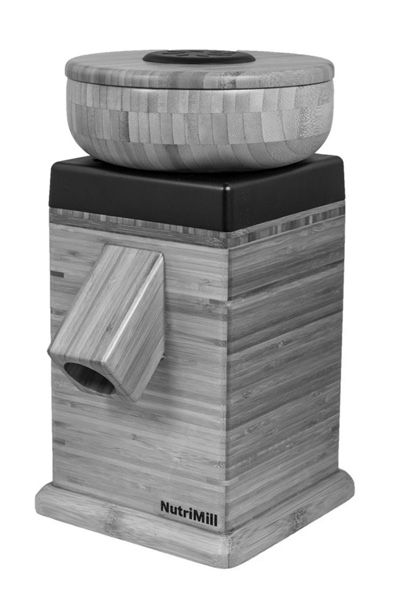
NutriMill Harvest Grain Mill
The beautiful bamboo-covered NutriMill Harvest Grain Mill (pictured) is a stone grain mill designed especially for healthy grain nutrition and gourmet cooking. It grinds fresh flour on demand and adjusts easily from fine bread flour to cracked grains. It will grind both grains and legumes and has an interchangeable insert to prevent cross-contamination for those who desire gluten-free grain.
MockMill
The MockMill, like the KoMo mill, is designed by Wolfgang Mock, and is a top-quality stone-grinding mill whose grinding capability adjusts from finely-ground bread flour to cracked grain. Similar in design to the KoMo and Nutrimill mills, it will grind any hard grain or legume. This mill is notable because it grinds faster and produces a finer flour than similar mills. It is distributed by Breadtopia and is supported by how-to-use tutorials.
Retsel Mil-Rite Mill
The Retsel Mil-Rite Mill is a basic, sturdy mill that uses stones to produce a very fine flour and is excellent for high-quality bread making. It has interchangeable grinding parts, with both synthetic ceramic stones and stainless-steel milling burrs so that it can grind seeds, nuts, and oily grains as well as grains. These mills are sold direct from the manufacturer, Retsel Corporation, in McCammon, Idaho.
Manual Mills
Manual hand mills grind wheat without electricity which makes them perfect for a crisis. They range in price and quality. Several manual mills are very nice quality and are in the price range of electric mills. The less-expensive models are not very energy efficient and can take more than twenty minutes to mill a pound of fine flour. While some people find the manual work required for hand mills satisfying, others find it a tedious, physical strain. Manual grinding may be more successful if grains are ground on a coarse setting first and then reground on a fine setting.
Before selecting a manual grain mill, check the quality of the flour, the amount produced for the effort, and the ease and comfort of the grinding operation.
Also, be aware that manual mills need to be either screwed to a solid surface or clamped onto a counter. If you don’t want your wheat grinder permanently attached to your countertop, consider the two-screw clamp designs for stability and distributing the force of the clamp.
Mills with large grinding surfaces, smooth ball bearing action, and flywheels make manual milling easier and more efficient. Good manual mills often come with or offer options such as additional burrs, grain-flaking and meat-grinding attachments, and handle extensions.
Country Living Grain Mill
The Country Living Grain Mill (pictured) is an outstanding durable mill that uses an effortless bearing system with substantial carbon-steel grinding burrs.
Its smooth mechanism is easy to turn, and it will grind pastry quality flour as well as cracked wheat and most other grains.

GrainMaker Grain Mill
The GrainMaker grain mill (pictured) is made in Montana by a family-owned-and-operated company that prides itself on its quality products, craftsmanship, and customer service. The entire mill, including the stones, has a lifetime heirloom guarantee—the best guarantee for any mill. It is an excellent hand mill with large grinding stones and a smooth flywheel mechanism and will make pastry flour for bread making or cracked wheat for cereal. It can be motorized and is available with several attachments that help with that process.
Diamant Grain Mill
The Diamant Grain Mill is a European grain mill that is built to last and is similar in function to the Country Living Grain Mill and the GrainMaker Grain Mill. It will make pastry quality flour as well as cracked wheat. It is sturdy and well designed with a smooth-running flywheel.
Lehman’s Own Hand-Cranked Grain Mill
Lehman’s motto is “Simple products or a simpler way of life.” They offer a range of quality hand kitchen tools for the home and farm. Designed to meet Lehman’s specifications, Lehman’s Own Hand-Cranked Grain Mill offers both quality and economy and grinds wheat comparable to more expensive mills.
Retsel Uni-Ark Grain Mill
Manufactured and sold by the Retsel Corporation in McCammon, Idaho, the Uni-Ark Grain Mill is known for its durability and flexibility and for being made “without a piece of plastic.” It comes with ceramic stones and optional steel wheels so it will grind hard grains as well as oily grains and seeds.
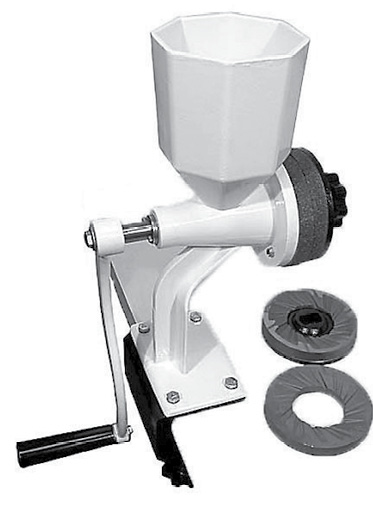
Wonder Junior and Wonder Junior Deluxe Mills
Both the Wonder Junior and Wonder Junior Deluxe (pictured) have stone grinding burrs for grains and dry legumes and a double substantial two-clamp system. The deluxe model comes with additional steel burrs for grinding oily seeds and making nut butters. Both mills can be motorized with a grooved pulley option set up to anything you can attach a belt to. They also have a unique drill attachment.
Roots and Branches Deluxe Grain Mill
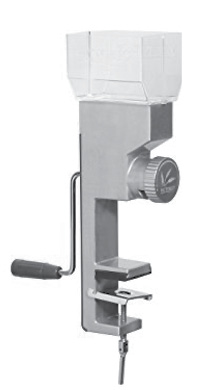
The Roots and Branches Deluxe Grain Mill (pictured) is an inexpensive hand mill that grinds coarse flour with a significant amount of effort. You can grind finer flour with a second time through the mill. It can also be fitted with an optional motor that replaces the handle.
Converting Manual Mills
Several top-quality manual mills have conversion kits so that you can operate them more efficiently with a bicycle or electric motor. The Wondermill Junior Deluxe mill even has a fitting that allows you to run the mill with a power drill. Retsel Corporation also has conversion kits for a variety of electrical adaptations.
It is not recommended that you try to adapt an electric mill to a manually turned mill unless it is specifically designed for that purpose.
Family Grain Mill System

The Family Grain Mill (pictured) has a modular system that can fit the stone-burr mill for either a hand-crank or electrical option. It can also be attached to Bosch, Kitchen Aid, and Viking mixers motors. It has a wide range of adjustments and several other kitchen tools can be fitted to its base.
Used manually, it will crack wheat as well as produce medium-fine flour. Double grinding the flour will get you a finer flour. Using the hand crank, it takes about thirty minutes to grind enough grain for one loaf of bread. The flour is coarse, but when ground a second time, it becomes more satisfactory for bread making.
Personally Speaking
You might be hoping I will recommend a grain mill, but you really can’t go wrong with any of the mills I have listed. As you’ll see from the reviews, there are several fine mills available. Depending on your preference, I would get either one of the excellent electric mills or top-quality manual mills.
I own several, but the one I use most is my Blendtec Kitchen Mill. We bought the first one over thirty years ago. When I gave it to one of my daughters a few years ago, I bought another one because I liked it so well. On the other hand, one of my daughters-in-law loves her Wondermill—especially because there is no dust. But both are great because of their speed and convenience. I recently purchased the Nutrimill Harvest Grain Mill with milling stones, which gives me a few more options for grinding cereals—and I love its handsome bamboo casing. I also have a nice manual mill set aside in case we have a prolonged crisis without electricity.
Bread Mixers
The second-most important kitchen machine for using grains is a good bread mixer. Of course, bread can be made without a bread mixer, but if you plan to make very much bread, this appliance is invaluable. There are several quality mixers on the market, and generally the price point of the mixer will equate to its quality.
Almost all mixers have an assortment of useful attachments that might be included as incentives or offered for purchase. Be aware that the number of watts of the motor does not necessarily equate with the actual torque power of the machine. Rather, it’s often just a marketing gimmick. Do your research and read reviews.
Mixers are loosely divided into three categories: medium-duty, mainstream all-purpose; specialized, heavy-duty designed primarily for bread making; and extra-heavy-duty, near-commercial-grade all-purpose mixers.
All-Purpose Stand Mixers
Breville, Cuisinart, and KitchenAid lead the market in medium-duty, all-purpose stand mixers. Besides adequately performing standard mixing chores, some of the more powerful models also handle kneading bread. Breville, based in Australia, is a relative newcomer to stand mixers, but their mixer is first-rate. Cuisinart’s top high-performing mixer has a powerful motor and a three-year warranty. KitchenAid, a staple in kitchen mixers, makes multiple mixer models that vary in power and ability. They make so many models you must be careful as you select a model to be sure you are getting the desired quality and power.
Specialized Bread-Kneading Heavy-Duty Stand Mixers
Some mixers are designed specifically for making large quantities of bread dough. These heavy-duty mixers are powered from below on a drive shaft. They are large capacity and will make six or more loaves of bread. They will also perform other mixing duties and often have attachments for grinding, shredding, and slicing. They can be found in shops that cater to the preparedness and homesteading communities and on the internet sites of similar companies. The most popular bread-making mixers are Anakarsrum, Blendtec, Bosch, and WonderMix.
Ankarsrum

The Ankarsrum mixer (pictured) is exceptionally high quality, Swedish-made, and offers innovative features, such as an infinite variable speed, an automatic shut-off timer, and a wide range of attachments and accessories. It has a six-quart mixing bowl and comes in a variety of colors.
Blendtec Mix ‘n Blend
Blendtec, known for its high-capacity blender and powerful grain mill, also makes a heavy-duty mixer that is excellent for bread making. The four-quart mixer comes with a French whisk, cookie whisk, and dough-hook assembly. It also comes with a blender. Look for it on Blendtec’s website.
Bosch Mixer

The Bosch Universal Plus Mixer (pictured) is another excellent large-capacity bread maker. It has a 6.5-quart bowl that can handle as many as nine one-and-a-half-pound loaves and as few as one or two. It typically comes with a dough hook and a whisk but has many optional attachments, like shredders, a grater, a citrus juicer, a meat grinder, and even an ice cream maker.
WonderMix Kitchen Mixer
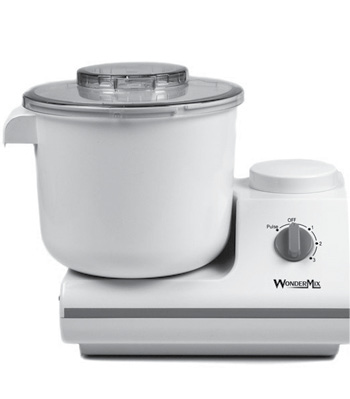
The WonderMix Kitchen Mixer (pictured) is made by the same company that makes the WonderMill. It has a 5.5-quart bowl capacity and strong nine-hundred-watt motor. It has several accessories that make it a complete kitchen tool, including a slicer-shredder, meat grinder, and flaker.
Commercial-Grade Mixers
If you require an exceptionally heavy-duty kitchen mixer, the Hobart Company, maker of many commercial mixers, offers the Hobart N50 five-quart, three-speed, all-purpose bench mixer. It costs about $2,500 and is interchangeable with KitchenAid accessories. It is one-sixth horsepower and has a gear-driven transmission.
Other Food-Processing Tools and Equipment
Some storage foods need processing that requires specialized tools that you may need to purchase.
Grain Roller/Flakers

If you plan to store whole grain oats or desire to have fresh whole-rolled grains or grain flakes, you may want a grain roller. The Margo Mulino Oat Roller (pictured) made in Italy is a stand-alone, hand-cranked flaker that makes nice rolled oats.
Other harder grains need to be soaked first before they can be satisfactorily rolled. The Family Flaker Mill is another option. It is a module of the Family Grain Mills and can be cranked by hand or by using the Family Grain Mill power base. It makes excellent rolled oats and other grain flakes without presoaking. Flaker attachments are available for the Ankarsrum, Bosch, and KitchenAid mixers. KoMo also makes a separate grain flaker.
Blenders

Besides normal kitchen uses, a blender is a useful preparedness tool for mixing noninstant powdered milk, making mayonnaise, blending breakfast drinks, etc. Blenders made by Vitamix (pictured) and Blendtec are top-quality, high-powered machines useful for many food-prep functions. Oster and Kitchen Aid make two well-reviewed, mid-priced blenders. Nutra Ninja Pro Blender is a great value. Of course, all blenders require electricity. A rotary eggbeater and a whisk are good nonelectric alternatives.
©2020 Vitamix Corporation. Printed with permission. All rights reserved
Kitchen Knives
Table 19.1
|
|
|
Minimum Knife Needs |
Additional Knife Options |
|
|
In crises, you are more likely to need quality kitchen knives. Look for forged knives with full tangs for high performance and durability. Be sure the knife feels balanced and is easy to manage. Stamped knives are usually not as high quality and do not perform as well. Table 19.1 lists the minimum knives you should have.
Whatever knives you have, keeping them sharp ensures they are safe and reliable. You will need a sharpening steel or ceramic rod to straighten the blade edges after each use and a whetstone, diamond-impregnated rod, or other abrasive for occasional sharpening. To help protect knives, store them properly in a countertop or in-drawer knife block.
Table 19.2
|
|||
|
|
|
|
Basic Nonelectric Kitchen Tools and Equipment
Table 19.3
|
|
|
|
Many kitchen tools use electricity, but in an emergency, you may need an equivalent manual tool. You may also need to prepare food you usually purchase already prepared and that may require special tools. The list of manual, general food-preparation tools in table 19.2 will help you plan. Check to see which ones you do not already own. Table 19.3 lists basic equipment for cooking. Tools needed specifically for food preservation are not included here but will be discussed in chapters 28–32.
Cast-Iron Cookware
If you plan on cooking on woodstoves, in fireplaces, or over campfires, you’ll need a set of pots and pans equal to the task. Lightweight steel or aluminum pans with nonstick coatings will develop hot spots and quickly burn through if used directly on or over a fire. The best cooking pots for open fires are heavy cast-iron pots, kettles, skillets, griddles, and Dutch ovens. Cast iron works well for slow cooking over all heats. It is easy to clean and lasts forever if properly seasoned and cared for. It can also be buried under coals and conserves heat. You’ll need an iron rod or swinging arm crane if you expect to suspend kettles in a fireplace.
Pressure Cookers
A pressure cooker, smaller than a pressure canner, is an important preparedness kitchen tool. It consumes less fuel for cooking, cuts cooking time for many recipes by two-thirds, and can be used with alternative heat sources. It is indispensable for cooking beans, grains, and many dehydrated foods. Pressure cookers may be stovetop or electric. Look for one that has multiple settings for more cooking options.
Cookbooks
Although you may need to make some substitutions, many of your regular recipes will be suitable for the foods you store. However, you may want some specialized cookbooks for recipes using whole grains, legumes, powdered milk, and dehydrated foods. Also, because they are so different from what most people are used to, a book or two on woodstove and fireplace cooking may be helpful if you plan to use either of these alternative cooking methods.
Kitchen Supplies
Table 19.4
|
|
|
|
Regular household utensils and dishes should be satisfactory (see table 19.4), although a backup set of nonbreakable plastic dishes is advisable. Also consider disposable utensils and paper napkins, plates, and cups for use when water is in low supply or ease of preparation is necessary. Store all paper products in a dry and somewhat cool area and protected from rodents.
Making Basic Food Products
